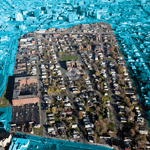The newly named SALT District in Syracuse, New York, is being revitalized by Raimi + Associates, an urban planning firm based in Berkeley, California, an increasingly common story being spun in cities across the United States. Yet the most innovative aspect of the SALT District’s renewal is not the improvements made to the network of sidewalks or the green, single-family homes, but the creative mechanism that Raimi + Associates used to assess the existing neighborhood.
By using LEED’s criteria for new neighborhood developments (LEED-ND), the urban planners were able to identify the strengths of the existing community as well as areas in need of improvement. This gave the team a clearer idea of what a sustainable community in Syracuse would look like. The result is a revitalized and reimagined neighborhood near downtown Syracuse and a success story for the many organizations involved, including the Near West Side Initiative, Syracuse Center of Excellence, and the nonprofit Home HeadQuarters.

Syracuse, NY’s 8,400-resident SALT District makes up 156 acres of the Near West Side. Its revitalization also includes planting native trees, creating a network of paths for bicycles and pedestrians, and building numerous live/work spaces, including the award-winning R-House (left), and the 30,000-square-foot Lincoln Apartments.
The SALT District exemplifies Raimi + Associates’ core tenant of planning and designing through the lens of public health. “There had been a lot of good work done in the neighborhood before we were involved,” says Matt Raimi, a principal at Raimi + Associates. “We pushed the process forward and deepened the conversation about sustainability. We also had the idea to use the LEED-ND criteria as a tool, not to evaluate a specific development project but to craft a long-range plan for a neighborhood to fill in the gaps and make it better.” Raimi + Associates has applied this innovative strategy to other neighborhoods with great success, especially when combined with another idea integral to the firm’s philosophy: urban planning that takes into account socioeconomic realities.
The SALT District is a neighborhood in the traditional sense, containing housing and jobs, public amenities such as schools and parks, and walkable streets. Its name is both a nod to the past—the area was the site of industrial salt-making during the early part of the 19th century—and an acknowledgement of its evolution: SALT is an acronym for Syracuse, Art, Life, Technology. In recent years, the community has been subject to a depressed economic situation and rampant disinvestment; vacant lots and unemployment rates in Syracuse are among the highest in New York. But out of turmoil comes opportunity. The existing neighborhood framework lent itself to community-building. “We went in and looked at what the neighborhood’s strengths were,” Raimi says. “The original layout was a strength.”
Raimi + Associates’ LEED-ND evaluation identified numerous other advantages, but it also identified challenges. For instance, the firm’s plan called for a complete mapping and reworking of the sidewalk system, which is a requirement for LEED-ND certification, communities must have sidewalks on both sides of streets, and sidewalks must form a complete network. The existing system was disjointed because a portion of the area was part of a prior urban renewal initiative in the 1950s in which vertical-style housing projects were built. These subdivisions, like many similar buildings, became problematic in the way of poverty and crime, and they were cut off from the street network. Raimi + Associates recommended that these subdivisions be redesigned to reestablish connectivity to the street, and a range of different housing types that were more in line with the rest of the neighborhood were developed.
Some of this housing was conceptualized through a design competition called “From the Ground Up,” organized by the Syracuse Center for Excellence and Home HeadQuarters. Architects were invited to submit green designs for single-family homes, and the winners had their designs financed, built, and sold to prospective homeowners in the community. The competition brought innovative and beautiful homes to the neighborhood; it also brought an increase in home ownership rates, something that Home HeadQuarters promotes as a means to neighborhood stability.
The SALT District is bordered on the east side by a creek and railroad tracks that separate the neighborhood from the most culturally affluent part of downtown Syracuse, and it’s this area that Raimi + Associates sees as a priority and place of opportunity in the transformation of the community. Enhanced connections to downtown Syracuse are opportunities for remaking the thread between the SALT District and the downtown job and cultural center. It recommended safety improvements to roadways, strategies for transforming the creek into an amenity, and establishing new pedestrian connections.
The planners also added new parks and gardens on vacant land. “Preserving nature and incorporating nature into cities is important, but we really focus on creating environments that are good for people and their health,” Raimi says. “That ranges from economic opportunity and education all the way down to sidewalks and access to healthy foods. When we do planning work, we look at that from the beginning.”

